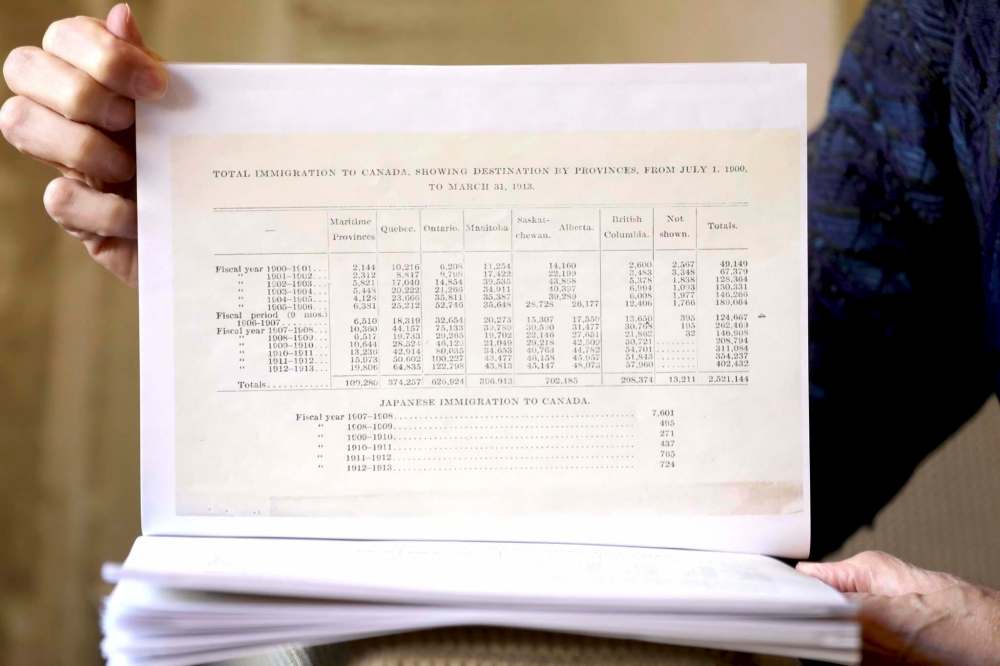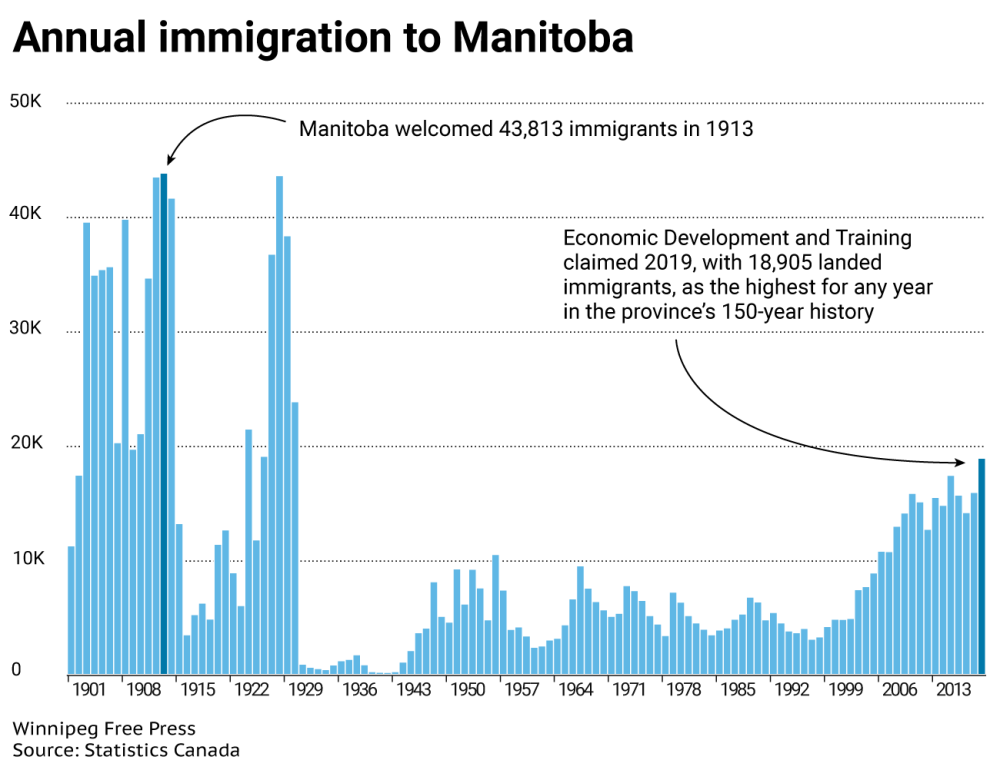Province wrong to boast of highest-ever immigration
Read this article for free:
or
Already have an account? Log in here »
To continue reading, please subscribe:
Monthly Digital Subscription
$0 for the first 4 weeks*
- Enjoy unlimited reading on winnipegfreepress.com
- Read the E-Edition, our digital replica newspaper
- Access News Break, our award-winning app
- Play interactive puzzles
*No charge for 4 weeks then price increases to the regular rate of $19.00 plus GST every four weeks. Offer available to new and qualified returning subscribers only. Cancel any time.
Monthly Digital Subscription
$4.75/week*
- Enjoy unlimited reading on winnipegfreepress.com
- Read the E-Edition, our digital replica newspaper
- Access News Break, our award-winning app
- Play interactive puzzles
*Billed as $19 plus GST every four weeks. Cancel any time.
To continue reading, please subscribe:
Add Free Press access to your Brandon Sun subscription for only an additional
$1 for the first 4 weeks*
*Your next subscription payment will increase by $1.00 and you will be charged $16.99 plus GST for four weeks. After four weeks, your payment will increase to $23.99 plus GST every four weeks.
Read unlimited articles for free today:
or
Already have an account? Log in here »
Hey there, time traveller!
This article was published 13/02/2020 (2130 days ago), so information in it may no longer be current.
The province’s trumpeting of 2019’s immigration numbers as the highest in Manitoba’s 150-year history is an “egregious mistake,” says a Winnipeg immigration history expert.
Last year, 18,905 immigrants came to Manitoba. That’s well below the historic high of 43,813 in the fiscal year 1912-13, and well below the 30,531 annual average during the first 13 years of the 20th century, says Robert Vineberg.

The historian, retired regional director of immigration for the federal government and chair of the board of trustees at the Canadian Museum of Immigration at Pier 21 in Halifax, knows about Manitoba immigration, and where to find the records.
“It seems to me that the province’s database doesn’t go back far enough,” Vineberg said in response to a news release issued by the Manitoba government Tuesday. It was headlined “Manitoba accepts highest number of immigrants in province’s history.”
In the release, Economic Development and Training Minister Ralph Eichler said the number of immigrant landings in Manitoba in 2019 reached 18,905, “the highest for any year in the province’s 150-year history.”
When asked on Wednesday to verify that claim, a government spokesman responded late Thursday, saying immigration in 2019 was the highest in the province’s “modern history.”

(function() {
var paidAccessCheck = function(){
if($(“.paidaccess”).css(“display”) == “block”){
var elements = Array.prototype.slice.call(document.querySelectorAll(“.g-artboard[data-min-width]”)),
widthById = {};
elements.forEach(function(el) {
var parent = el.parentNode,
width = widthById[parent.id] || parent.getBoundingClientRect().width,
minwidth = el.getAttribute(“data-min-width”),
maxwidth = el.getAttribute(“data-max-width”);
widthById[parent.id] = width;
if (+minwidth = width || maxwidth === null)) {
el.style.display = “block”;
} else {
el.style.display = “none”;
}
});
try {
if (window.parent && window.parent.$) {
window.parent.$(“body”).trigger(“resizedcontent”, [window]);
}
if (window.require) {
require([‘foundation/main’], function() {
require([‘shared/interactive/instances/app-communicator’], function(AppCommunicator) {
AppCommunicator.triggerResize();
});
});
}
} catch(e) { console.log(e); }
clearInterval(verifyPaidAccess);
}
}
var verifyPaidAccess = setInterval(paidAccessCheck,500);
// only want one resizer on the page
if (document.documentElement.className.indexOf(“g-resizer-v3-init”) > -1) return;
document.documentElement.className += ” g-resizer-v3-init”;
// require IE9+
if (!(“querySelector” in document)) return;
function resizer() {
var elements = Array.prototype.slice.call(document.querySelectorAll(“.g-artboard[data-min-width]”)),
widthById = {};
elements.forEach(function(el) {
var parent = el.parentNode,
width = widthById[parent.id] || parent.getBoundingClientRect().width,
minwidth = el.getAttribute(“data-min-width”),
maxwidth = el.getAttribute(“data-max-width”);
widthById[parent.id] = width;
if (+minwidth = width || maxwidth === null)) {
el.style.display = “block”;
} else {
el.style.display = “none”;
}
});
try {
if (window.parent && window.parent.$) {
window.parent.$(“body”).trigger(“resizedcontent”, [window]);
}
if (window.require) {
require([‘foundation/main’], function() {
require([‘shared/interactive/instances/app-communicator’], function(AppCommunicator) {
AppCommunicator.triggerResize();
});
});
}
} catch(e) { console.log(e); }
}
document.addEventListener(‘DOMContentLoaded’, resizer);
// feel free to replace throttle with _.throttle, if available
window.addEventListener(‘resize’, throttle(resizer, 200));
function throttle(func, wait) {
// from underscore.js
var _now = Date.now || function() { return new Date().getTime(); },
context, args, result, timeout = null, previous = 0;
var later = function() {
previous = _now();
timeout = null;
result = func.apply(context, args);
if (!timeout) context = args = null;
};
return function() {
var now = _now(), remaining = wait – (now – previous);
context = this;
args = arguments;
if (remaining wait) {
if (timeout) {
clearTimeout(timeout);
timeout = null;
}
previous = now;
result = func.apply(context, args);
if (!timeout) context = args = null;
} else if (!timeout && options.trailing !== false) {
timeout = setTimeout(later, remaining);
}
return result;
};
}
})();
#g-immigration-top20-box ,
#g-immigration-top20-box .g-artboard {
margin:0 auto;
}
#g-immigration-top20-box p {
margin:0;
}
#g-immigration-top20-box .g-aiAbs {
position:absolute;
}
#g-immigration-top20-box .g-aiImg {
position:absolute;
top:0;
display:block;
width:100% !important;
}
#g-immigration-top20-box .g-aiSymbol {
position: absolute;
box-sizing: border-box;
}
#g-immigration-top20-box .g-aiPointText p { white-space: nowrap; }
#g-immigration-top20-mobile-small {
position:relative;
overflow:hidden;
}
#g-immigration-top20-mobile-small p {
font-weight:500;
line-height:7px;
height:auto;
filter:alpha(opacity=100);
-ms-filter:progid:DXImageTransform.Microsoft.Alpha(Opacity=100);
opacity:1;
letter-spacing:0em;
font-size:6px;
text-align:left;
color:rgb(0,0,0);
text-transform:none;
padding-bottom:0;
padding-top:0;
mix-blend-mode:normal;
font-style:normal;
position:static;
}
#g-immigration-top20-mobile-small .g-pstyle0 {
font-weight:700;
line-height:15px;
height:15px;
font-size:13px;
}
#g-immigration-top20-mobile-small .g-pstyle1 {
font-weight:700;
line-height:36px;
height:36px;
font-size:12px;
}
#g-immigration-top20-mobile-small .g-pstyle2 {
height:7px;
}
#g-immigration-top20-mobile-small .g-pstyle3 {
line-height:11px;
height:11px;
font-size:8px;
}
#g-immigration-top20-mobile-small .g-pstyle4 {
line-height:11px;
height:11px;
font-size:9px;
}
#g-immigration-top20-mobile-large {
position:relative;
overflow:hidden;
}
#g-immigration-top20-mobile-large p {
font-weight:500;
line-height:13px;
height:auto;
filter:alpha(opacity=100);
-ms-filter:progid:DXImageTransform.Microsoft.Alpha(Opacity=100);
opacity:1;
letter-spacing:0em;
font-size:10px;
text-align:left;
color:rgb(0,0,0);
text-transform:none;
padding-bottom:0;
padding-top:0;
mix-blend-mode:normal;
font-style:normal;
position:static;
}
#g-immigration-top20-mobile-large .g-pstyle0 {
font-weight:700;
line-height:18px;
height:18px;
font-size:16px;
}
#g-immigration-top20-mobile-large .g-pstyle1 {
font-weight:700;
line-height:36px;
height:36px;
font-size:13px;
}
#g-immigration-top20-mobile-large .g-pstyle2 {
line-height:9px;
height:9px;
font-size:7px;
}
#g-immigration-top20-mobile-large .g-pstyle3 {
height:13px;
}
#g-immigration-top20-desktop {
position:relative;
overflow:hidden;
}
#g-immigration-top20-desktop p {
font-weight:500;
line-height:17px;
height:auto;
filter:alpha(opacity=100);
-ms-filter:progid:DXImageTransform.Microsoft.Alpha(Opacity=100);
opacity:1;
letter-spacing:0em;
font-size:14px;
text-align:left;
color:rgb(0,0,0);
text-transform:none;
padding-bottom:0;
padding-top:0;
mix-blend-mode:normal;
font-style:normal;
position:static;
}
#g-immigration-top20-desktop .g-pstyle0 {
font-weight:700;
line-height:36px;
height:36px;
font-size:28px;
}
#g-immigration-top20-desktop .g-pstyle1 {
font-weight:700;
line-height:36px;
height:36px;
font-size:18px;
}
#g-immigration-top20-desktop .g-pstyle2 {
height:17px;
}
#g-immigration-top20-desktop .g-pstyle3 {
line-height:16px;
height:16px;
}
#g-immigration-top20-desktop .g-pstyle4 {
line-height:14px;
height:14px;
font-size:12px;
}
/* Custom CSS */
.gi.ai2html {
margin-bottom: 1em;
}
.gi.ai2html p {
text-shadow: 1px 1px 0px rgba(255,255,255,0.7), -1px -1px 0px rgba(255,255,255,0.7), -1px 1px 0px rgba(255,255,255,0.7), 1px -1px 0px rgba(255,255,255,0.7);
}
.gi.ai2html #no-shadow p {
text-shadow: none !important;
}
@media screen and (max-width: 375px) {
#gi-0213-mb-immigration-top20-mobile-small,
#gi-0213-mb-immigration-top20-mobile-large,
#gi-0213-mb-immigration-top20-desktop {
display: none;
}
#gi-0213-mb-immigration-top20-mobile-small {
display: block;
}
}
@media screen and (min-width: 375px) and (max-width: 500px) {
#gi-0213-mb-immigration-top20-mobile-small,
#gi-0213-mb-immigration-top20-mobile-large,
#gi-0213-mb-immigration-top20-desktop {
display: none;
}
#gi-0213-mb-immigration-top20-mobile-large {
display: block;
}
}
@media screen and (min-width: 501px) {
#gi-0213-mb-immigration-top20-mobile-small,
#gi-0213-mb-immigration-top20-mobile-large,
#gi-0213-mb-immigration-top20-desktop {
display: none;
}
#gi-0213-mb-immigration-top20-desktop {
display: block;
}
}

Top 20 years of immigration to Manitoba
Annual number of immigrants
4
3
,
8
1
3
1
9
1
3
4
3
,
5
9
6
1
9
2
8
4
3
,
4
7
7
1
9
1
2
4
1
,
6
4
0
1
9
1
4
3
9
,
7
8
9
1
9
0
8
3
9
,
5
3
5
1
9
0
3
3
8
,
3
4
0
1
9
2
9
3
6
,
7
3
9
1
9
2
7
3
5
,
6
4
8
1
9
0
6
3
5
,
3
8
7
1
9
0
5
3
4
,
9
1
1
1
9
0
4
3
4
,
6
5
3
1
9
1
1
2
3
,
8
3
7
1
9
3
0
Economic Development and
Training claimed 2019, with
18,905 landed immigrants,
as the highest for any year
in the province’s
150-year history
2
1
,
4
5
1
1
9
2
4
2
1
,
0
4
9
1
9
1
0
2
0
,
2
7
3
1
9
0
7
1
9
,
7
0
2
1
9
0
9
1
9
,
0
7
9
1
9
2
6
1
8
,
9
0
5
2
0
1
9
Winnipeg Free Press
Source: Statistics Canada

Top 20 years of immigration to Manitoba
Annual number of immigrants
4
3
,
8
1
3
1
9
1
3
4
3
,
5
9
6
1
9
2
8
4
3
,
4
7
7
1
9
1
2
4
1
,
6
4
0
1
9
1
4
3
9
,
7
8
9
1
9
0
8
3
9
,
5
3
5
1
9
0
3
3
8
,
3
4
0
1
9
2
9
3
6
,
7
3
9
1
9
2
7
3
5
,
6
4
8
1
9
0
6
3
5
,
3
8
7
1
9
0
5
3
4
,
9
1
1
1
9
0
4
3
4
,
6
5
3
1
9
1
1
2
3
,
8
3
7
1
9
3
0
Economic Development and
Training claimed 2019, with
18,905 landed immigrants,
as the highest for any year
in the province’s
150-year history
2
1
,
4
5
1
1
9
2
4
2
1
,
0
4
9
1
9
1
0
2
0
,
2
7
3
1
9
0
7
1
9
,
7
0
2
1
9
0
9
1
9
,
0
7
9
1
9
2
6
1
8
,
9
0
5
2
0
1
9
Winnipeg Free Press
Source: Statistics Canada

Top 20 years of immigration to Manitoba
Annual number of immigrants
4
3
,
8
1
3
1
9
1
3
4
3
,
5
9
6
1
9
2
8
4
3
,
4
7
7
1
9
1
2
4
1
,
6
4
0
1
9
1
4
3
9
,
7
8
9
1
9
0
8
3
9
,
5
3
5
1
9
0
3
3
8
,
3
4
0
1
9
2
9
3
6
,
7
3
9
1
9
2
7
3
5
,
6
4
8
1
9
0
6
3
5
,
3
8
7
1
9
0
5
3
4
,
9
1
1
1
9
0
4
3
4
,
6
5
3
1
9
1
1
2
3
,
8
3
7
1
9
3
0
2
1
,
4
5
1
1
9
2
4
Economic Development and Training
claimed 2019, with 18,905 landed
immigrants, as the highest for any year
in the province’s 150-year history
2
1
,
0
4
9
1
9
1
0
2
0
,
2
7
3
1
9
0
7
1
9
,
7
0
2
1
9
0
9
1
9
,
0
7
9
1
9
2
6
1
8
,
9
0
5
2
0
1
9
Winnipeg Free Press
Source: Statistics Canada
Contrary to the province’s news release, every year from 1904-05 to 1912-13, immigration to Manitoba exceeded the 2019 total, said Vineberg, who has downloaded PDFs of the annual Canada Year Book from Statistics Canada. He also has a copy of Immigration Facts and Figures, issued by the Federal Department of the Interior in 1913. In those days, immigration data was reported by fiscal year.
Throughout the decade 1902-03 to 1912-13, immigration to Manitoba varied from a low of 19,702 in 1908-09 to the high of 43,813 in 1912-13. In the first 13 years of the 1900s, Manitoba received 396,913 immigrants, for an annual average of 30,531.
“The main reasons for this were the attraction of free land, subsidized transportation from the U.K., and large numbers of immigrants coming from the European continent due to Clifford Sifton (who owned the Free Press) being minister of the interior from 1896 to 1905, and beginning the recruitment of immigrants from the continent,” said Vineberg. That immigration wave continued until the First World War cut off immigration, except from the U.S., he said.

The population growth in the years before the First World War gained steam again in the 20s when it really boomed and the government wanted to continue the populating and settling of the Prairies that had taken place before the First World War. “There were a number of programs subsidizing their passage and passage loans, particularly to British people,” said Vineberg.
“Someone could get to Winnipeg from Liverpool for as little as two or three pounds.” In 2020, that’s about $200, adjusting for inflation and currency exchange.
“That encouraged a lot of people to come,” said Vineberg, noting that Canada’s railways operated shipping lines and had negotiated agreements with the federal immigration department to select people who would be suitable agricultural or domestic workers.
“It was in their interest to select more and more,” he said. The Department of Immigration and Colonization, as it was called, wanted to populate the West, not overpopulate the big cities in the east, said Vineberg, who paraphrased a minister who said: “If they want to come out west and farm, we’re going to help them.”
“All that ended with the Depression,” he said. “The doors were pretty well closed.”
During the Second World War, it was extremely difficult for immigrants to come from Europe because all shipping went to the war effort. Annual immigration levels to Manitoba dwindled to around 3,000 per year at the end of the 20th century before bouncing back with the creation of the provincial nominee program, said Vineberg.
The new immigration scheme was introduced by Progressive Conservative Premier Gary Filmon to help people with skills and family connections immigrate to Manitoba. It became a model for other provinces trying to attract and retain newcomers.
While the current Tory government made an “egregious mistake” touting 2019 immigration as the highest in Manitoba’s 150-year history, Vineberg said he hopes Manitobans understand how important high levels of immigration are to the economy, and that they learn from history.
“When immigration has boomed, Manitoba has boomed. When immigration has dropped off, the economy has slowed right down.”
Manitoba’s minister in charge of immigration gets that. “As a significant driver of economic and population growth, immigration is shaping the future of this province,” Eichler said in Tuesday’s press release.
“It is a critical tool in Manitoba’s economic growth action plan to ensure we reach our goal of creating 40,000 jobs over the next four years, moving Manitoba forward.”
carol.sanders@freepress.mb.ca

Our newsroom depends on a growing audience of readers to power our journalism. If you are not a paid reader, please consider becoming a subscriber.
Our newsroom depends on its audience of readers to power our journalism. Thank you for your support.
History
Updated on Thursday, February 13, 2020 11:21 PM CST: Fixes quote










